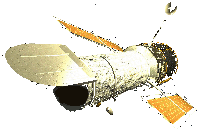











The Hubble Space Telescope, nearing the imposed end of its life, now in its 16th year of discovery and clarity, is trained, for the image above, on a small section of the Tarantula Nebula (also known as 30 Doradus or as NGC 2070), located 168,000 light-years away in the Large Magellanic Cloud. In Tarantula, the full spectrum of stellar dynamics is at work, with stars beginning and ending their lives with spectacular effect. Exploding supernovae from older stars in the Hodge 301 star cluster, located below and to the right of the area seen above, are sending shock waves into the nebula, forming the green and white filaments and veils of gas that make the Tarantula so beautiful. The last Hodge 301 supernova lit the region in 1987. Hodge 301, looking like diamonds and rubies strewn in the light of the sun, is one of the most explosive regions in our Milky Way galaxy's local group, with three of its golden supergiant stars poised to erupt and, like the 1987 supernova seed the nebula with their gases and heavy elements.The local group principally consists of The Milky Way, its dominant, 2.3-light-year-distant spiral sister galaxy, Andromeda (also known as M31), the Large and Small Magellanic Clouds, each of which are irregular-shaped galaxies (as opposed to the spiral structure of the Milky Way and Andromeda or globular structure of some other, usually older galaxies), and also within the local group, several medium galaxies and at least a dozen dwarf and other minor galaxies which are orbiting or merging with the principal galaxies in the group.
In Tarantula, where gases have been compressed by shock and where gravity has done its birthing work, new stars are emerging, and protostars, whose gases have formed into shrouded globes, where within, their stellar fuels are building under increasing pressure and heat toward ignition, have developed and are beautifully defined in the image as the small, gray nodules, some located just left of center.
The image above is actually a small part of the whole picture captured by the Hubble Space Telescope, and that whole picture, along with hundreds of the most beautiful images from space, and more, can be yours in a matter of days with the SpaceScapes™ CD. But, for a smaller picture of the full image above, click on the image, or the SpaceScapes™ links, and you will travel to confront the region of the Tarantula Nebula containing its gems, Hodge 301, in all their glory.



Tarantula is the first installment of the series Cosmic Paint, which will direct visitors to the most beautiful off-Earth objects in the Universe, most captured by the Hubble Space Telescope, which has rightly seized a monopoly on visible imaging in space. We who marvel at the beauty and power of the Universe owe a debt of thanks to the scientists and engineers in universities, observatories and in government and private laboratories who have created the technologies and refined the knowledge that extends our vision and understanding ever closer toward the point of creation.

Text is Copyright © Silkscape Arts - All rights reserved